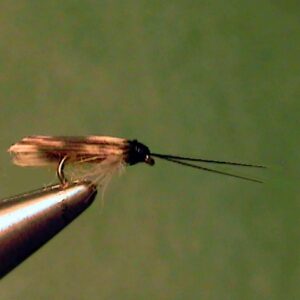Hook Size: 20
The Perfect Fly Speckled Peter Caddis Pupa trout fly imitates the Speckled Peter Caddis larva stage of life. Their larvae live in a case type shelter until the pupa is formed just prior to the hatch. Just prior to the hatch, the pupa comes out of its case and accents from the bottom of the stream to the surface where it emerges into an adult. This makes them easy prey for trout. They should be fished from the bottom to the surface of the water by first allowing the fly to sink to the bottom and then bringing the fly up to the surface using the current and the tip of the rod.
We feel certain the trout eat the pupae during the hatch more than any other stage of
he Speckled Peter’s life. According to the entomologist, these caddisflies hatch in the
water on the surface. They are so small, it’s difficult to see this going on when your on
the water late in the day.
The best time to catch trout on the Speckled Peter pupa fly pattern is just before dark.
If it’s a heavily overcast day, you may want to start earlier in the afternoon an hour or
two prior to dark. You want to cast the Perfect Fly Speckled Peter Pupa in an upstream
direction if it’s possible to do so without spooking the trout. Sometimes, if the water is
very smooth, a downstream presentation works better. Either way you want to fish
within a few feet of the banks. We think the pupae may swim towards the banks and
emerge near them as opposed to mid-stream. That’s where you will observe the adults
flying and on the water after they have hatched.
We recommend adding a little weight to the tippet about six inches above the fly. Don’t
over do it. You only want enough to allow the fly to slowly sink to near the bottom. Too
much weight will hinder the fly returning back to the surface in slower flowing water.
If you fish the pupa imitation in smooth water, cast it slightly down and across and allow
the fly to sink some by mending your line. Stop the rod movement and allow the current
to bring the fly back to the surface. That’s usually the point at which the trout will take
it. You want to continue moving downstream a step or two at a time to cover the banks.
If you fish in an upstream direction, use an up and across presentation, and mend the
line a couple of times until the fly is downstream of your position. You will want the fly to
swing all the way around downstream of your position. Stop the rod at about a forty-five
degree angle and allow the current to return the fly to the surface.
Copyright 2013 James Marsh

